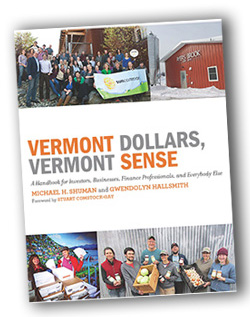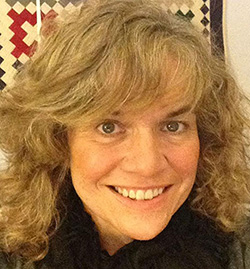Book ReviewInvest Locally: Vermont Dollars, Vermont Sense Shows How |
||||
| by Rickey Gard Diamond | ||||
 |
Since most Vermont women are not rolling in dough, you may not think of yourself as an investor. But if you breathe Vermont air, drink its water, shop at its local businesses, and have a credit union or community bank’s debit card, you are part of an investment revolution—whether you knew it or not. Vermont Dollars, Vermont Sense, a new handbook by economist Michael Shuman and Vermont town planner Gwendolyn Hallsmith (with research help from a St. Michael’s grad student), makes it clear that our state’s citizens are already committed to keeping more of our dollars at home. For instance, the Vermont Community Foundation has committed to investing 5 percent of its donors’ dollars in Vermont ventures here. Since their holdings are now $8 million, this isn’t chump change. Last year the foundation’s investments yielded development funds for Vermont affordable housing, childcare, farms, food, and energy. Cooperatives are another form of local investment gaining interest in Vermont. When Betsy Pratt was ready to sell Mad River Glen, a ski resort high in the mountains of Fayston, she decided the people she trusted to protect its local character were skiers who loved it. In 1995, while the ski industry was getting bigger and more cookie-cutter-alike, Pratt’s loyal skiers formed a cooperative; it’s now owned outright by 1,800 individuals with 2,300 shares, all with some say in the cooperative’s mission “to preserve and protect the forest and mountain eco-system.” |
|||
Consumer choices are another form of investment, the authors say. They point to recent data from the US Department of Agriculture, revealing we eat more locally grown food per capita than any other state. One way that many Vermont farms raise money is by preselling their produce through CSAs (community supported agriculture). People pay for shares of the crop in April, when farms need cash to plant, and then get regular produce deliveries all summer and fall. Presales have helped raise capital locally for restaurants, too. The Bee’s Knees restaurant in Morrisville, Kismet in Montpelier, and Claire’s Restaurant and Bar in Hardwick have all raised funds this way. When a flood damaged the much-beloved Savoy Theater in Montpelier, the theater presold movie tickets to pay for repairs.
Small business owners are not the only ones affected by underinvestment in Main Street. A new generation of young workers would be better served by local businesses than by national or multinational ones. In the challenging period after the 2008 crash through 2013, authors note that while big businesses cut their workforce by 4.3 percent, local businesses led growth by creating new jobs at 1.2 percent. Edward L. Glaeser and William R. Kerr, in a 2010 Harvard Business Review article (“The Secret to Job Growth: Think Small”), put it simply: “More Small Firms Mean More Jobs.” Surprisingly, that’s because small businesses are more competitive and have a higher rate of profit than large businesses. Today’s average Wall Street investor in Standard & Poor’s 500 index will make just 2.7 percent return, according to Yale’s Robert Shiller, who recently won the Nobel prize in economics. Who knew? In the most recent data available, for 2008, the IRS found sole proprietor businesses (the most common small-business startup) netted income 11 times that of C corporations (corporations that are taxed separately from their owners). While some retail and small business startups are riskier, older and established local businesses just keep on chugging, providing local livelihoods. Local businesses are ones owned by people who live where their business operates. If they own a franchise and are allowed independence, they’re local; if their stock is traded on NASDAQ or the New York Stock Exchange, they’re not. Businesses with far-removed owners “leak” Vermont money to other states or nations, and without owners in residence, their priorities are less likely to attend to local concerns than someone who lives here. Small, local businesses are still the rule in Vermont, not the exception. Locally owned businesses tend to spend more money locally, producing an economic multiplier effect, say the authors. Studies show that because they look their neighbors in the eye, local small businesses tend to contribute to civil society as volunteers, donators, or through locally led civic initiatives. Perhaps that accounts for Vermont’s high membership numbers in the organization, Businesses for Social Responsibility—higher than any other state.
The authors challenge trends widely accepted by Wall Street’s “globalization.” That “too big to fail” corporate economy is underwritten by national trade agreements, government subsidies for fossil fuel, and tax policies that keep multinational corporations’ overhead and energy costs relatively low. But as coal and oil supplies diminish and wages go up in China and India, the cost of import and export will inevitably also go up. Right now US corporations manufacture durable goods—like appliances, automobiles, and computers—and their parts in locations far away from US customers and labor rules, but these goods represent only about a quarter of US purchases. Services and nondurable goods, like food, clothing, and paper, are where we spend most of our dollars—and nondurables must be produced or distributed locally. Not only do Shuman and Hallsmith argue that small is beautiful; they make the case that locals and the long game for investments are a wiser bet. You would think that since local businesses create more than half the US economy, in terms of both jobs and production, investors with capital would be eager to grow and protect it on Main Street. Yet almost none of Wall Street’s money now gets there. There are roadblocks in the way for at least a portion of Vermont’s billions to make it to Main Street. The authors explain that since the Great Depression, the laws ruling securities have created a kind of investment apartheid. There are the “accredited” investors, and then there are the rest of us. How do you get accredited? Do you need a degree? A license? No. Accredited investors are merely the richest 2 percent of Americans. That’s it. The richest capitalists are allowed to invest wherever they like. The rest of us are stuck with Wall Street—or were until recently. Securities laws seek to protect the amateur investor, namely most of us. A small local company, like Ben & Jerry’s before Unilever bought it, could create a public offering that allows the wider public to invest. But high costs and lawyer fees, an arduous process, and reports to regulators tend to discourage companies and local investors from finding each other. However, the passage of the JOBS Act (Jumpstart Our Business Startups) in 2012 allows new exemptions that enable unaccredited investors to put their money where they live. Businesses and investors just need to learn about them, which is the mission of Shuman and Hallsmith’s book. Discussed are direct private offerings, public offerings, crowd funding, long-term convertible notes that protect equity, peer to peer lending, and more. The book explains how tools work, and frequently illustrates them with examples of businesses whose names you may recognize. The story of High Mowing Seeds, for instance, shows multiple options and the process for combining solutions with Clean Yields Assets Management, Slow Money investors, and a local foundation. Each of the book’s sections focuses on dozens of investment methods and tools, describing how each one works and what the challenges may be. Its simple language makes this all surprisingly readable. Its examples and lively photos of working neighbors reminds us of what the economy is really about: our land and our people. Contact information throughout makes this a hands-on tool, inviting questions and connections. Some methods have already been well tested, like muni bonds and land trusts. A few are new dreams for the future, like the as-yet unrealized public bank for public funds, a Local Vermont dedicated CD, a Vermont Mutual Fund—and yes, even a state stock market. Once every state had a local stock exchange. Again, who knew? Since Hallsmith and Shuman plan more presentations, and more state guides, the country’s Main Streets may well see this again. Vermont Dollars, Vermont Sense: A Handbook for Investors, Businesses, Finance Professionals and Everybody Else, 2015, is available as a free download at the Post Carbon Institute or in a paper edition only at www.postcarboninstitute.org. |
||||
|
Contributing editor Rickey Gard Diamond lives in Montpelier. In 2012 she won a National Newspaper Award for her Vermont Woman series, “An Economy of Our Own.” A national board member of The Public Banking Institute, she is currently at work on a book called Screwnomics: Making Economics Sexy; What Women Need to Know to Make Change.
|
|||

